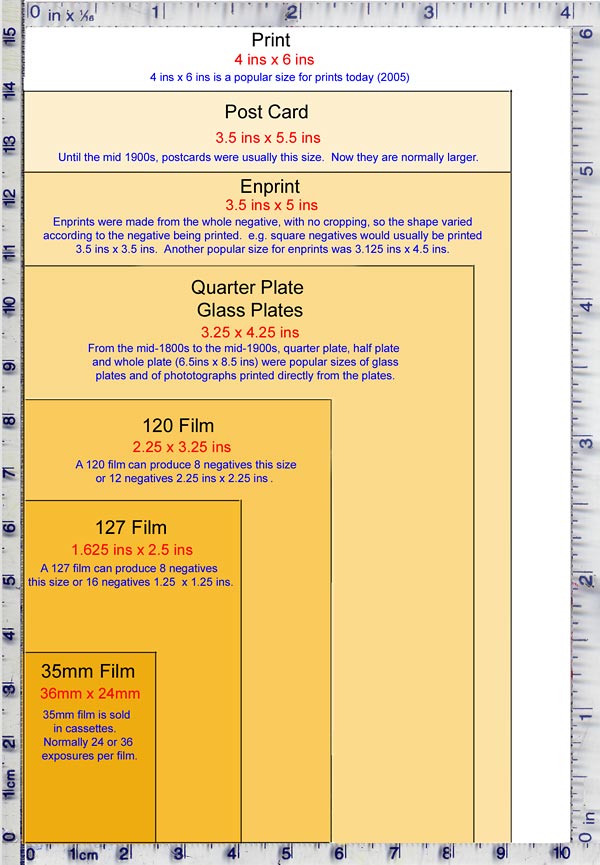|
|
Edinburgh University,
School of Literature,
Language and Cultures,
Celtic and Scottish Studies
2nd Year
Lecture: February 22, 2010 -
Ethnographic Photography
|
Ethnographic Photography -
Page 2 - Further Notes
|
Ethnographic Photography in Scotland
Types of Camera
and
Types of Photo
|
|
Further Notes |
|
Daguerreotype
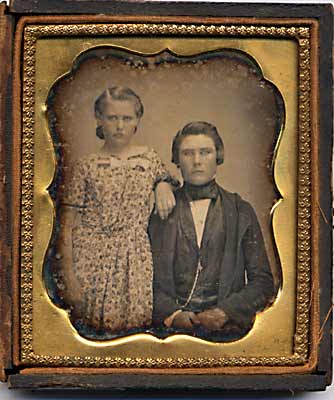 ©
©
-
The image on the plate was very delicate so was
covered with glass for protection.
-
Colour was added to some Daguerreotypes. This
was a delicate process. Masks were cut for the shape of each
colour. Then the artist would gently sprinkle a little finely
ground colour and breath on the surface to make the colour adhere.
Albumen
Prints
-
Prints, in the 1850s, would normally be made as 'contact prints' -
i.e. the print would be the same size as the negative, so to get a
large print, the photographer needed a large glass plate and a lot of
chemicals and a large camera.
-
Here are examples of a carte de visite and a cabinet
print.
Stereo Views
-
Stereo views became popular in the 1850s.
There is a man standing in front of the statue in the right-hand
image, but he cannot be seen in the left-hand image. So the
photograph appears to have been taken by a camera that had a single
lens.
Duke of Wellington Statue
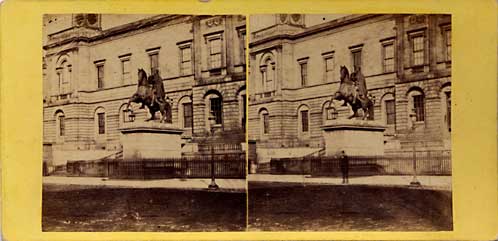
©
Copyright:
For
permission to reproduce, please contact peter.stubbs@edinphoto.org.uk
Photogravure
Prints
Photogravure
Thomas Annan
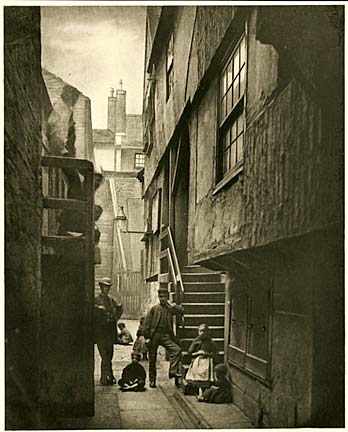
© Reproduced
with acknowledgement to Fine Art Dealer Paul Cava
-
There was movement towards more artistic photography
in the 1890s. Some prominent members of the Royal
Photographic Society broke away from the RPS to form the The
Linked Ring in 1892. They produced photos that they believed went
beyond the scientific and had artistic merit. Many of these by
Henry Peach Robinson, J Craig Annan and others were reproduced as high
quality photogravure prints in Alfred
Stieglitz' journal, Camera Work, between 1903 and 1917.
-
Here are some examples of photogravure photos -
views of 'Old Closes and Streets of Glasgow' taken by
Thomas Annan, the father of James Craig Annan in the late 1860s, then
reproduced as photogravures in 1900. These were produced to make
a documentary record of the closes that were soon to be demolished,
but the photos have a pictorial quality.
From
1880
Amateur Photographers
-
With photography becoming easier, the number of
photographers and number of photographic societies throughout Britain
increased.
-
Here are a couple of adverts for cameras sold by
Lizars (now Black & Lizars) of Shandwick Place, Edinburgh about a
hundred years ago:
Advert 1
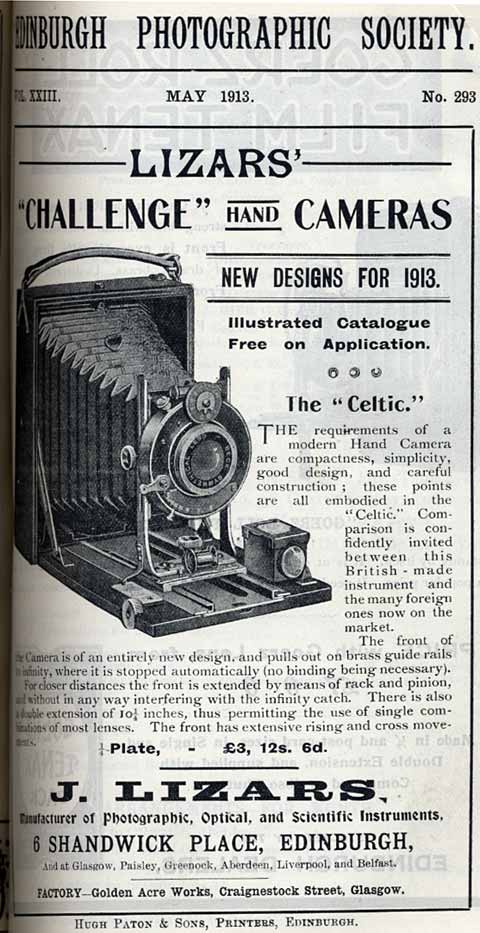
©
Reproduced
by courtesy of Edinburgh Photographic Society
Advert 2
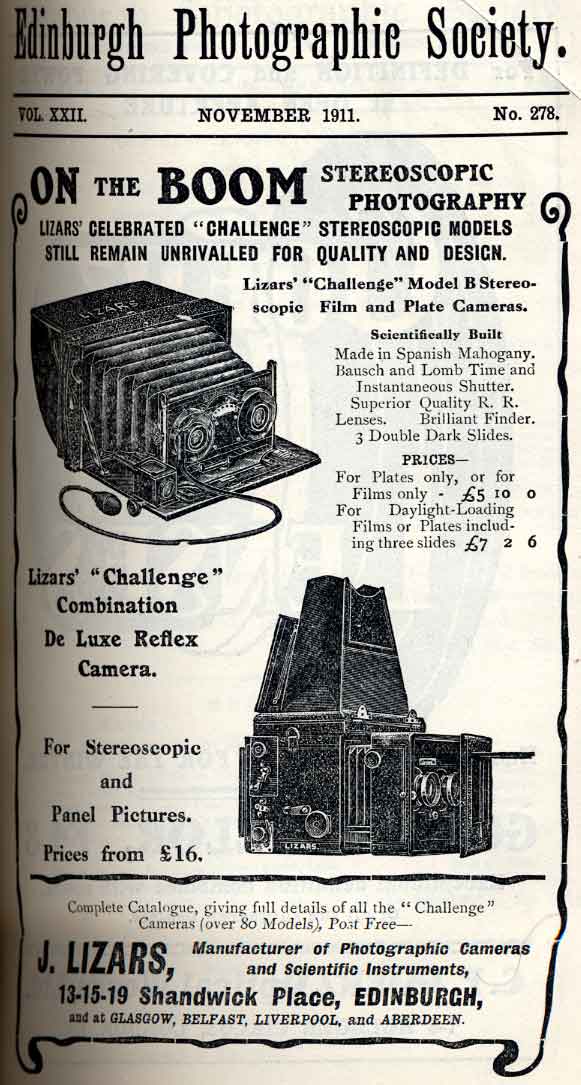
©
Reproduced
by courtesy of Edinburgh Photographic Society
Cameras
and
Film
-
There were now more photographers throughout Britain
than there had been in the 19th century. But photography,
including the materials, could be costly and there were still
many people who had no camera and relied
on trips to Jeromes to get their photos taken for birthdays and other
occasions.
-
The Autochrome process
for colour photography became available in 1907, but was not widely
used. Kodachrome introduced
their first colour film in 1935 but it was very slow (only 6 ASA).
However, the speed was increased and Kodachrome continued to be sold
until 2009.
-
There have been many changes in cameras and film
since 1920:
-
Large format cameras,
with large plates, were used by the press for most of the 20th
Century, but are now largely seen.
-
Medium format film
cameras (i.e. taking 120 size film) were popular until very recently
with studio photographers and other professional photographers, but
now most professionals seem to have accepted that they can get at
least as good results with professional digital cameras.
-
Cameras with folding bellows
were popular with keen photographers in the first half of the 20th
century, but these photographers were likely to move on to
35mm
SLR (single lens reflex) cameras with their inter-changeable lenses around the 1950s/60s then on to digital
SLR cameras in the early
2000s.
-
Many more features have been added to
SLR cameras over the years - split screen
focus, auto-focus, motor drive, programme mode, auto-bracketing, TTL
flash, etc. Even an 'entry-level' digital SLR now has many more
features than a 'top-of-the-range' SLR had a couple of decades ago.
-
At the other end of the range,
disk cameras with their miniature film size were introduced in
1982, but discontinued in 1999.
-
Instant photo cameras were introduced by
Polaroid in 1963, but with the advent of
digital cameras, Polaroid 'instant pictures' no longer have the same
appeal. Polaroid recently discontinued making their film.
-
Disposable cameras
using 35mm film and cheap plastic lenses have been sold
by Fuji since 1986 and by Kodak since 1988. They are easy to use
and inexpensive. They are now often left on the tables at
weddings so that guests can capture their own images of the event.
|
___________________________________
End of Page 1
|





